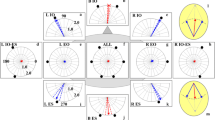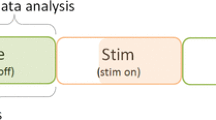Abstract
It has been shown that torso-based vibrotactile feedback significantly reduces postural sway in balance-compromised adults during quiet standing and in response to perturbations. This study aimed to determine whether vibrotactile stimulations applied to different torso locations induced directional postural responses and whether torso cutaneous information contributes to body representation. Eleven healthy young adults equipped with an inertial measurement unit (IMU) placed on the torso were asked to maintain an upright posture with closed eyes. Six vibrators (tactors) were placed on the torso in contact with the skin over the left and right external oblique, internal oblique, and erector spinae muscles at the L4/L5 level. Each tactor was randomly activated four times per location at a frequency of 250 Hz for a period of 5 s. The IMU results indicated that vibration applied individually over the internal oblique and erector spinae muscles induced a postural shift of about one degree oriented in the direction of the stimulation, while simultaneous activation of all tactors and activation of tactors over external oblique muscles produced insignificant postural effects. The root mean square of the sway signal was significantly higher during vibration than before or after. However, the center of pressure displacement, measured by a force plate, was uninfluenced by any vibration. These results suggest a multi-joint postural response including a torso inclination associated with vibration-induced changes in cutaneous information. The directional aspect of vibration-induced postural shifts suggests that cutaneous information from the stimulated areas contributes to proprioception and upper body spatial representation.







Similar content being viewed by others
Abbreviations
- ANOVA:
-
Analysis of variance
- A/P:
-
Anterior–posterior
- COG:
-
Center of gravity
- COP:
-
Center of pressure
- DFT:
-
Discrete Fourier transform
- HSD:
-
Honestly significant difference
- IMU:
-
Inertial measurement unit
- M/L:
-
Medial–lateral
- PSD:
-
Power spectral density
- RMS:
-
Root mean square
References
Aimonetti JM, Hospod V, Roll JP, Ribot-Ciscar E (2007) Cutaneous afferents provide a neuronal population vector that encodes the orientation of human ankle movements. J Physiol 580(2):649–658
Burke D, Hagbarth KE, Löfstedt L, Wallin BG (1976a) The response of human muscle spindle endings to vibration of non-contracting muscles. J Physiol 261(3):673–693
Burke D, Hagbarth KE, Löfstedt L, Wallin BG (1976b) The responses of human muscle spindle endings to vibration during isometric contraction. J Physiol 261(3):695–711
Calvin-Figuiere S, Romaiguere P, Gilhodes JC, Roll JP (1999) Antagonist motor responses correlate with kinesthetic illusions induced by tendon vibration. Exp Brain Res 124(3):342–350
Collins DF, Prochazka A (1996) Ankle muscle stiffness in the control of balance during quiet standing. J Physiol 496(3):857–871
Collins DF, Refshauge KM, Todd G, Gandevia SC (2005) Cutaneous receptors contribute to kinesthesia at the index finger, elbow, and knee. J Neurophysiol 94(3):1699–1706
Davis JR, Carpenter MG, Tschanz R, Meyes S, Debrunner D, Burger J, Allum JH (2010) Trunk sway reductions in young and older adults using multi-modal biofeedback. Gait Posture 31(4):465–472
Dietz V (1992) Human neuronal control of automatic functional movements: interaction between central programs and afferent input. Physiol Rev 72(1):33–69
Edin BB (1992) Quantitative analysis of static strain sensitivity in human mechanoreceptors from hairy skin. J Neurophysiol 67(5):1105–1113
Edin BB (2001) Cutaneous afferents provide information about knee joint movements in humans. J Physiol 531(1):289–297
Edin BB, Abbs JH (1991) Finger movement responses of cutaneous mechanoreceptors in the dorsal skin of the human hand. J Neurophysiol 65(3):657–670
Edin BB, Vallbo AB (1990) Muscle afferent responses to isometric contractions and relaxations in humans. J Neurophysiol 63(6):1307–1313
Eklund G (1969) Influence of muscle vibration on balance in man. A preliminary report. Acta Soc Med Ups 74(3–4):113–117
Eklund G (1972) General features of vibration-induced effects on balance. Ups J Med Sci Suppl 77(2):112–124
Gatton M, Pearcy M, Pettet G (2001) Modelling the line of action for the oblique abdominal muscles using an elliptical torso model. J Biomech 34(9):1203–1207
Gilhodes JC, Roll JP, Tardy-Gervet MF (1986) Perceptual and motor effects of agonist-antagonist muscle vibration in man. Exp Brain Res 61(2):395–402
Goodwin GM, McCloskey DI, Matthews PB (1972) The contribution of muscle afferents to kinaesthesia shown by vibration induced illusions of movement and by the effects of paralysing joint afferents. Brain 95(4):705–748
Gregoric M, Takeya T, Baron JB, Bessineton JC (1978) Influence of vibration of neck muscles on balance control in man. Agressologie 19(A):37–38
Grill SE, Hallett M (1995) Velocity sensitivity of human muscle spindle afferents and slowly adapting type II cutaneous mechanoreceptors. J Physiol 489(Pt 2):593–602
Gurfinkel VS, Lipshits MI, Lestienne FG (1988) Anticipatory neck muscle activity associated with rapid arm movements. Neurosci Lett 94(1–2):104–108
Haggerty S, Jiang LT, Galecki A, Sienko KH (2012) Effects of biofeedback on secondary-task response time and postural stability in older adults. Gait Posture 35(4):523–528
Hayashi R, Miyake A, Jijiwa H, Watanabe S (1981) Postural readjustment to body sway induced by vibration in man. Exp Brain Res 43(2):217–225
Horak FB, MacPherson JM (1996) Postural orientation and equilibrium. In: Rowell LB, Shepard JT (eds) Handbook of physiology Oxford University Press, New York
Horak FB, Shupert CL (1994) Role of the vestibular system in postural control. Vestibular rehabilitation, Philadelphia
Huffman JL, Norton LE, Adkin AL, Allum HJ (2010) Directional effects of biofeedback on trunk sway during stance tasks in healthy young adults. Gait Posture 32(1):62–66
Hulliger M, Nordh E, Thelin AE, Vallbo AB (1979) The responses of afferent fibres from the glabrous skin of the hand during voluntary finger movements in man. J Physiol 291:233–249
Janssen JF, Verhoeff L, Horlings GC, Allum HJ (2009) Directional effects of biofeedback on trunk sway during gait tasks in healthy young subjects. Gait Posture 29(4):575–581
Johansson RS, Landström U, Lundström R (1982) Sensitivity to edges of mechanoreceptive afferent units innervating the glabrous skin of the human hand. Brain Res 244(1):27–32
Kasai T, Yahagi S, Shimura K (2002) Effect of vibration-induced postural illusion on anticipatory postural adjustment of voluntary arm movement in standing humans. Gait Posture 15(1):94–100
Kavounoudias A, Roll R, Roll JP (1999) Specific whole-body shifts induced by frequency-modulated vibrations of human plantar soles. Neurosci Lett 266(3):181–184
Kavounoudias A, Roll R, Roll JP (2001) Foot sole and ankle muscle inputs contribute jointly to human erect posture regulation. J Physiol 532(Pt 3):869–878
Kentala E, Vivas J, Wall C (2003) Reduction of postural sway by use of a vibrotactile balance prosthesis prototype in subjects with vestibular deficits. Ann Otol Rhinol Laryngol 112(5):404–409
Kirby RL, Price NA, MacLeod DA (1987) The influence of foot position on standing balance. J Biomech 20(4):423–427
Knibestol M, Vallbo AB (1970) Single unit analysis of mechanoreceptor activity from the human glabrous skin. Acta Physiol Scand 80(2):178–195
Kugelberg E, Hagbarth KE (1958) Spinal mechanism of the abdominal and erector spinae skin reflexes. Brain 81(3):290–304
Kuo AD (1995) An optimal control model for analyzing human postural balance. IEEE Trans Biomed Eng 42(1):87–101
Kuo AD, Zajac FE (1993) Human standing posture: multi-joint movement strategies based on biomechanical constraints. Prog Brain Res 97:349–358
Lackner JR (1988) Some proprioceptive influences on the perceptual representation of body shape and orientation. Brain 111(Pt 2):281–297
Lackner JR, Levine MS (1979) Changes in apparent body orientation and sensory localization induced by vibration of postural muscles: vibratory myesthetic illusions. Aviat Space Environ Med 50(4):346–354
Lackner JR, Rabin E, DiZio P (2000) Fingertip contact suppresses the destabilizing influence of leg muscle vibration. J Neurophysiol 84(5):2217–2224
Lee BC, Martin BJ, Sienko KH (2012a) Comparison of non-volitional postural responses induced by two types of torso based vibrotactile stimulations. In: Conference proceedings of the Haptics symposium, Vancouver, pp 195–198
Lee BC, Kim J, Chen S, Sienko KH (2012b) Cell phone based balance trainer. J Neuroengineering Rehabil 9(10):1–14. http://www.jneuroengrehab.com/content/9/1/10
Magnusson M, Johansson R (1989) Dynamic performance of vibration induced anterior-posterior sway during upright posture in normal subjects. Acta Otolaryngol Suppl 468:227–230
Martin BJ, Park HS (1997) Analysis of the tonic vibration reflex: influence of vibration variables on motor unit synchronization and fatigue. Eur J Appl Physiol Occup Physiol 75(6):504–511
Martin BJ, Gauthier GM, Roll JP, Hugon M, Harlay F (1980) Effects of whole-body vibrations on standing posture in man. Aviat Space Environ Med 51(1):778–787
Martin BJ, Roll JP, Hugon M (1990) Modulation of cutaneous flexor responses induced in man by vibration-elicited proprioceptive or exteroceptive inputs. Aviat Space Environ Med 61(10):921–928
Massion J (1992) Movement, posture and equilibrium: interaction and coordination. Prog Neurobiol 38(1):35–56
Nashner LM, Shupert CL, Horak FB, Black FO (1989) Organization of posture controls: an analysis of sensory and mechanical constraints. Prog Brain Res 80:411–418
Penfield W, Rasmussen T (1950) The cerebral cortex of man. MacMillan, New York
Peterka RJ (2002) Sensorimotor integration in human postural control. J Neurophysiol 88(3):1097–1118
Purves D, Augustine GJ, Fitzpatrick D, Katz LC, LaMantia A-S, McNamara JO (eds) (1997) Neuroscience. Sinauer, Sunderland
Ribot-Ciscar E, Vedel JP, Roll JP (1989) Vibration sensitivity of slowly and rapidly adapting cutaneous mechanoreceptors in the human foot and leg. Neurosci Lett 104(1–2):130–135
Roll JP, Roll R (1988) From eye to foot: a proprioceptive chain involved in postural control. In: Amblard B (ed) Posture and gait: development, adaptation and modulation. Elsevier, Amsterdam, pp 155–164
Roll JP, Vedel JP (1982) Kinaesthetic role of muscle afferents in man, studied by tendon vibration and microneurography. Exp Brain Res 47(2):177–190
Roll JP, Vedel JP, Ribot E (1989) Alteration of proprioceptive messages induced by tendon vibration in man: a microneurographic study. Exp Brain Res 76(1):123–222
Ross DA, Blasch BB (2000) Wearable interfaces for orientation and wayfinding. In: Annu ACM conference assistive technology proceedings, Arlington, VA, USA, pp 193–200
Sienko KH, Balkwill MD, Oddsson LI, Wall C (2008) Effects of multi-directional vibrotactile feedback on vestibular-deficient postural performance during continuous multi-directional support surface perturbations. J Vestib Res 18(5–6):273–285
Sienko KH, Vichare VV, Balkwill MD, Wall C (2010) Assessment of vibrotactile feedback on postural stability during pseudorandom multidirectional platform motion. IEEE Trans Biomed Eng 57(4):944–952
Sienko KH, Balkwill MD, Wall C (2012) Biofeedback improves postural control recovery from multi-axis discrete perturbations. J Neuroengineering Rehabil 9(53). doi:10.1186/1743-0003-9-53
Slijper H, Latash ML (2004) The effects of muscle vibration on anticipatory postural adjustments. Brain Res 1015(1–2):57–72
Van Veen HAHC, Van Erp JBF (2000) Tactile information presentation in the cockpit. In: Haptic human-computer interaction, Tokyo, Japan, pp 174–181
Vedel JP, Roll JP (1982) Response to pressure and vibration of slowly adapting cutaneous mechanoreceptors in the human foot. Neurosci Lett 34(3):289–294
Verhoeff L, Horlings GC, Janssen JF, Bridenbaugh A, Allum HJ (2009) Effects of biofeedback on trunk sway during dual tasking in the healthy young and elderly. Gait Posture 30(1):76–81
Vuillerme N, Pinsault N, Chenu O, Demongeot J, Payan Y, Danilov Y (2008) Sensory supplementation system based on electrotactile tongue biofeedback of head position for balance control. Neurosci Lett 431(3):206–210
Wall C, Weinberg MS, Schmidt PB, Krebs DE (2001) Balance prosthesis based on micromechanical sensors using vibrotactile feedback of tilt. IEEE Trans Biomed Eng 48(10):1153–1161
Wall C, Oddsson LE, Horak FB, Wrisley DW, Dozza M (2004) Applications of vibrotactile display of body tilt for rehabilitation. In: Conference proceedings IEEE Engineering in Medicine and Biology Society, San Francisco, CA, USA, pp 4763–4765
Wierzbicka MM, Gilhodes JC, Roll JP (1998) Vibration-induced postural posteffects. J Neurophysiol 79(1):143–150
Winter DA (1995) A.B.C. (Anatomy, Biomechanics, and Control) of balance during standing and walking. University of Waterloo, Waterloo
Winter DA, Patla AE, Prince F, Ishac M, Gielo-Perczak K (1998) Stiffness control of balance in quiet standing. J Neurophysiol 80(3):1211–1221
Acknowledgments
This research was supported by the National Science Foundation’s CAREER program (RAPD-0846471, funded under the American Recovery and Reinvestment Act of 2009). The authors acknowledge Jongwha Chang and the Center for Statistical Consultation and Research at University of Michigan for their consultation regarding statistical analysis and Seunghun Baek for assistance with figure presentation.
Author information
Authors and Affiliations
Corresponding author
Rights and permissions
About this article
Cite this article
Lee, BC., Martin, B.J. & Sienko, K.H. Directional postural responses induced by vibrotactile stimulations applied to the torso. Exp Brain Res 222, 471–482 (2012). https://doi.org/10.1007/s00221-012-3233-2
Received:
Accepted:
Published:
Issue Date:
DOI: https://doi.org/10.1007/s00221-012-3233-2




